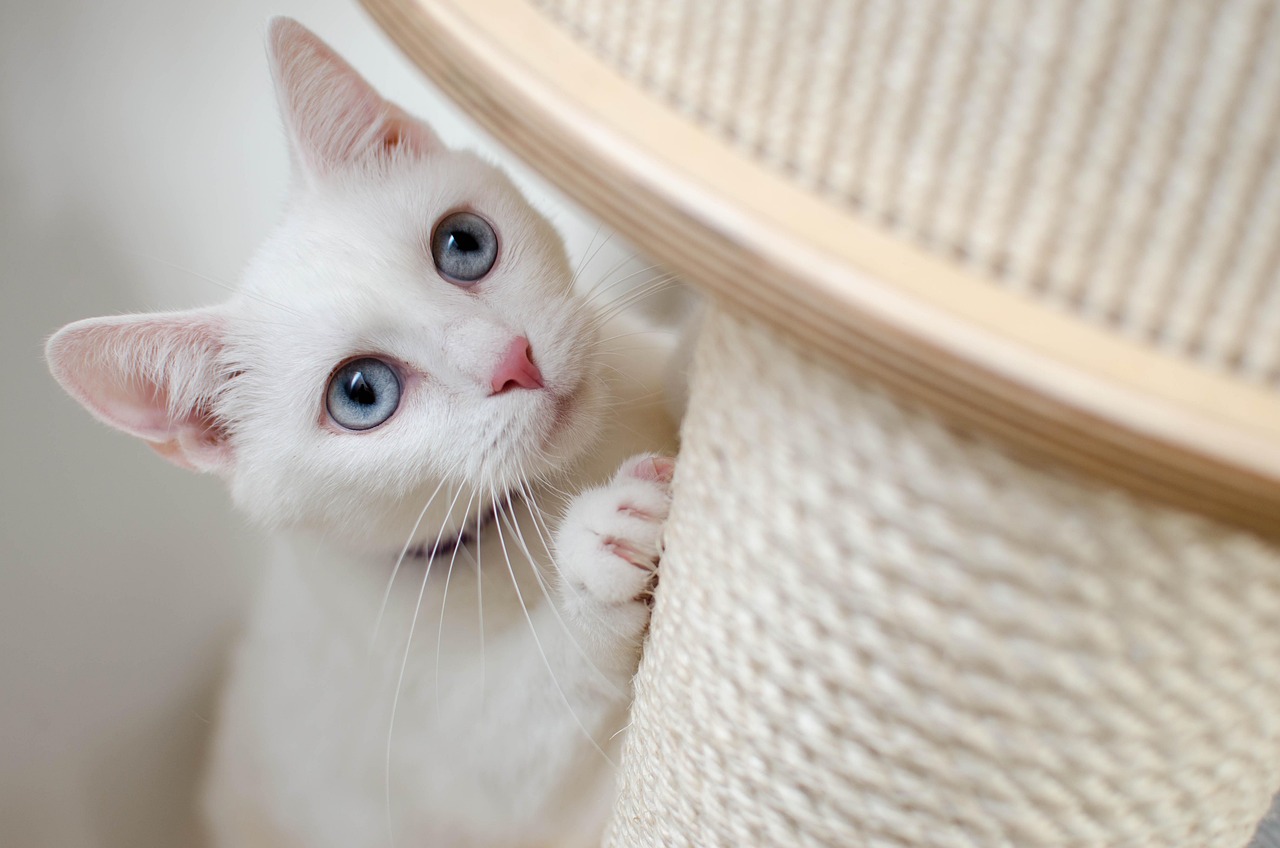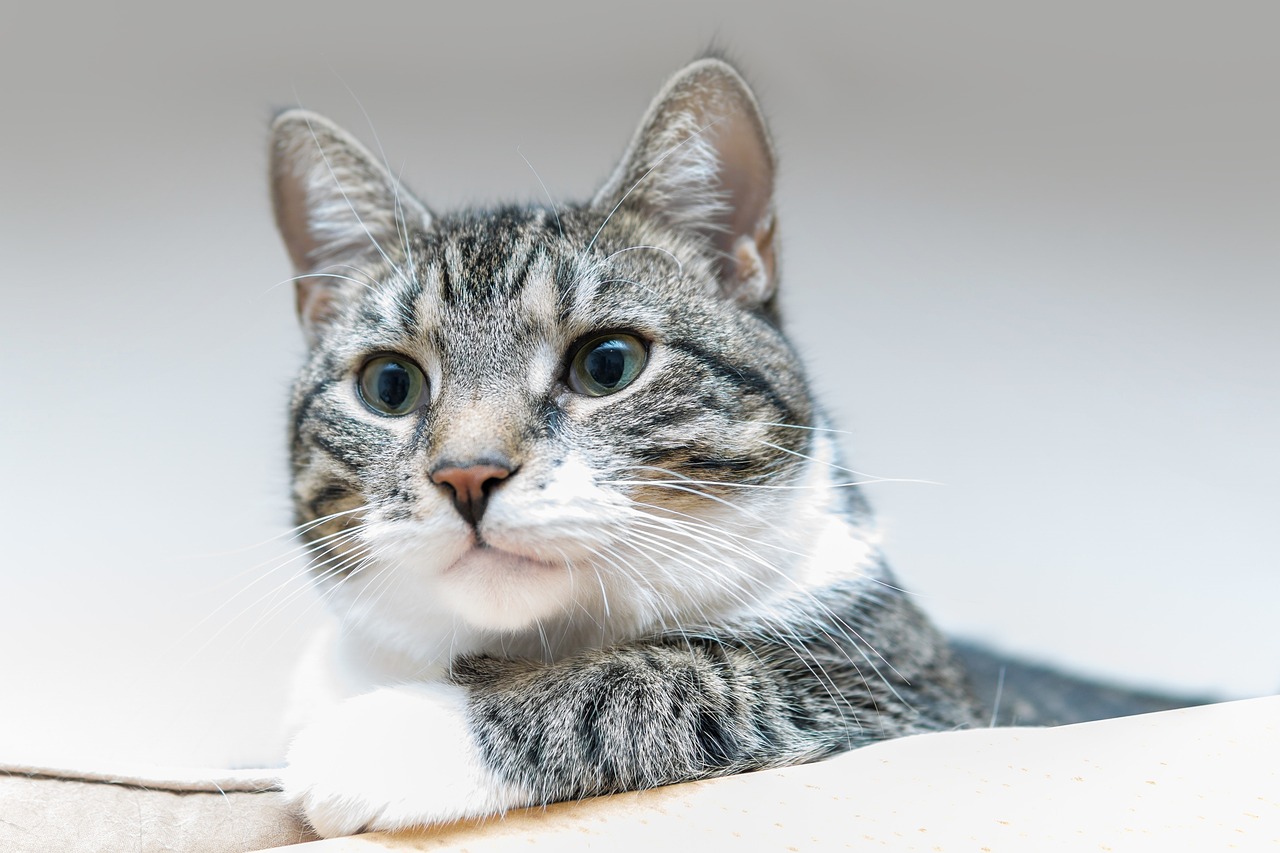Tips for Training Your Cat to Walk on a Leash
Training your cat to walk on a leash can be an incredibly rewarding experience, both for you and your furry friend. Imagine the joy of taking your cat out for a stroll, exploring the great outdoors together, and enjoying the fresh air. But before you can hit the trails, there are some essential tips and techniques that you need to consider to ensure a successful training process. This article will guide you through the steps necessary to transform your indoor kitty into a confident outdoor explorer.
Cats are fascinating creatures with unique behaviors that can significantly impact the leash training process. It's crucial to understand these behaviors to create a positive environment for training. For instance, some cats may be naturally curious and eager to explore, while others might be more timid and cautious. Recognizing your cat’s personality traits can help you tailor your training approach. If your cat tends to shy away from new experiences, you’ll want to introduce the leash and harness slowly, ensuring they feel safe and secure. Remember, patience is key! Just like humans, each cat is different, and what works for one may not work for another.
When it comes to leash training, selecting the appropriate harness and leash is vital for your cat's comfort and safety. The right gear can make all the difference in how your cat reacts to the experience. You want to choose equipment that fits well and allows for easy movement without causing discomfort. In this section, we’ll discuss the various types of harnesses and leashes available, helping you make an informed decision for your feline companion.
There are several harness designs suitable for cats, each with its own pros and cons. Here’s a quick overview of the most popular options:
| Type of Harness | Pros | Cons |
|---|---|---|
| Step-in Harness | Easy to use, secure fit | May not fit all body shapes |
| Vest Harness | Comfortable, good for nervous cats | Can be bulkier |
Step-in harnesses are a popular choice among cat owners due to their ease of use and secure fit. These harnesses allow your cat to simply step into them, making the process less stressful compared to over-the-head designs. They typically have adjustable straps, ensuring a snug fit that prevents escape during your outdoor adventures. Plus, they distribute pressure evenly across your cat's body, which is essential for their comfort.
If your cat tends to be a bit more anxious or requires extra support, vest harnesses might be the ideal option. These harnesses provide additional comfort and security, wrapping around your cat’s body more fully. They are especially beneficial for cats that may pull or try to escape, as they help distribute pressure across a larger area. Just keep in mind that they can be bulkier, so it’s important to ensure your cat is comfortable wearing one.
The type of leash you select can also impact your cat's walking experience. Leashes come in various materials and lengths, each suited for different training needs. A lightweight leash is often best for cats, as it allows for more freedom of movement without being cumbersome. A leash length of about 4 to 6 feet is generally ideal, giving your cat enough room to explore while still maintaining control. Consider choosing a leash with a comfortable grip, as you may be holding onto it for a while!
Before you can embark on your outdoor adventures, it’s essential to acclimate your cat to the harness. This process should be gradual and stress-free. Start by allowing your cat to sniff and explore the harness at their own pace. You can even place it near their favorite resting spot to create a positive association. The key is to ensure your cat feels comfortable and safe with the new equipment.
Utilizing positive reinforcement is crucial for successful training. Whenever your cat interacts with the harness or allows you to put it on, reward them with treats or praise. This encourages them to associate the harness with positive experiences. Over time, your cat will begin to see the harness as a fun accessory rather than a source of stress.
Gradual desensitization is another effective technique to help your cat adjust to the harness. Start by letting them wear the harness for short periods indoors, gradually increasing the duration as they become more comfortable. This slow approach helps reduce anxiety and builds confidence over time. Remember, every cat is different, so be sure to go at your cat’s pace.
Once your cat is comfortable with the harness, it’s time to begin outdoor training. Start in a quiet, familiar area where your cat can feel secure. Use a calm voice and gentle encouragement to guide them. Keep the first few sessions short and positive, gradually increasing the duration as your cat gains confidence. Always pay attention to their body language; if they seem anxious or overwhelmed, it’s best to take a step back and try again later.
Beginning leash training indoors allows your cat to familiarize themselves with the harness and leash in a controlled environment. This step is crucial for building their confidence. You can practice walking around the house, rewarding your cat for following you. This helps them learn to associate the leash with movement and exploration.
When you feel your cat is ready, venture outside for short, positive outdoor sessions. Start with just a few minutes, allowing your cat to explore their surroundings. Gradually increase the length of your walks as they become more comfortable. Always keep an eye on your cat's body language; if they seem stressed, it might be time to head back home.
Q: Can all cats be trained to walk on a leash?
A: While most cats can be trained, some may be more resistant than others. It’s important to be patient and understand your cat’s personality.
Q: How long does it take to train a cat to walk on a leash?
A: Training duration varies by cat. Some may adapt quickly, while others may take weeks or even months. Consistency and patience are key!
Q: What if my cat refuses to wear the harness?
A: If your cat is resistant, try introducing the harness more gradually and use positive reinforcement to encourage acceptance.

Understanding Your Cat's Behavior
When it comes to leash training your feline friend, understanding your cat's behavior is absolutely essential. Cats are intriguing creatures with unique personalities and quirks that can significantly influence how they respond to new experiences, including wearing a harness and walking on a leash. Just like people, each cat has its own comfort level when it comes to change, and this can make or break your training efforts.
First and foremost, it's important to recognize that cats are generally more cautious than dogs. They tend to be creatures of habit, preferring the familiar comforts of home over the unpredictability of the great outdoors. This means that introducing a leash to your cat may initially be met with resistance or anxiety. Think of it like asking a shy person to speak in front of a crowd; it requires patience and understanding.
Moreover, cats communicate through body language, and being attuned to these signals can help you gauge their comfort level. For instance, if your cat's ears are pinned back or their tail is puffed up, these are clear signs of distress. Alternatively, a relaxed posture, with ears forward and tail upright, indicates a more comfortable state. By observing these behaviors, you can adjust your training approach to better suit your cat's needs.
Another key aspect to consider is your cat's prior experiences. If your kitty has had negative encounters with harnesses or leashes in the past, they might associate these items with fear or discomfort. In such cases, it's crucial to take a step back and allow your cat to explore the harness in a safe and controlled environment. You might even consider using treats to create a positive association with the harness. Remember, patience is your best ally here!
To better understand the nuances of your cat's behavior during leash training, here are some common reactions you might encounter:
- Curiosity: Some cats may approach the harness with intrigue, sniffing it and exploring it. This is a good sign!
- Indifference: Others may simply ignore it, which can be a positive response, as long as they are not showing signs of fear.
- Fear: If your cat hides or shows signs of aggression, it's essential to slow down and reassess your approach.
Ultimately, understanding your cat's behavior is about building trust. By taking the time to recognize their feelings and adjusting your training methods accordingly, you can create a more positive experience for both you and your furry companion. Remember, every cat is unique, and what works for one may not work for another. So be attentive, be patient, and most importantly, have fun with the process!

Choosing the Right Equipment
When it comes to training your cat to walk on a leash, one of the most critical steps is . Just like a knight wouldn’t go into battle without their armor, your feline friend shouldn’t venture outdoors without the proper gear. The right harness and leash not only ensure your cat’s comfort but also their safety as they explore the great outdoors. So, let’s dive into the world of cat gear and find the perfect match for your furry companion!
First and foremost, you need to consider the type of harness that will best suit your cat's needs. There are several options available, each with its own set of advantages and disadvantages. For instance, some cats may prefer a snug fit, while others might feel more comfortable in a looser design. The key is to observe your cat's behavior and preferences. Below is a quick comparison table to help you understand the different types of harnesses:
| Type of Harness | Pros | Cons |
|---|---|---|
| Step-in Harness | Easy to use, secure fit | May require adjustment for comfort |
| Vest Harness | Extra comfort and support | Can be bulky for some cats |
| H-Style Harness | Good for escape artists | Can be tricky to put on |
Next up is the leash. The type of leash you choose can significantly impact your cat's walking experience. A lightweight leash is ideal for cats, as it allows them to move freely without feeling weighed down. Additionally, consider the length of the leash; a longer leash can give your cat more freedom to explore, while a shorter one offers better control in crowded or busy areas. Look for leashes made from durable materials that can withstand the wear and tear of outdoor adventures.
Ultimately, the right equipment can make all the difference in your cat's leash training journey. A well-fitted harness and a suitable leash will not only enhance your cat's comfort but also help build their confidence as they embark on new adventures. Remember, every cat is unique, so take your time to find the gear that works best for your furry friend!
Types of Harnesses
When it comes to leash training your feline friend, choosing the right harness is absolutely crucial. Think of the harness as a cozy jacket for your cat—one that needs to fit just right to ensure comfort and security. There are several types of harnesses available, each designed with different features that cater to various needs. In this section, we'll explore the most common types of harnesses and their respective pros and cons, helping you make an informed decision for your cat's leash training adventure.
First up, we have the step-in harnesses. These are incredibly user-friendly and perfect for cats who may be a bit skittish. To use one, you simply lay the harness on the ground, and your cat steps into it. Once they’re in, you can fasten it securely. This design minimizes the chance of tangling or fussing, making it a breeze for both you and your furry companion. The secure fit that step-in harnesses provide can make your cat feel safe, allowing them to focus on exploring rather than worrying about their gear.
Next, let’s talk about vest harnesses. These harnesses are often made of soft, padded materials, offering a snug fit around your cat’s body. The added comfort can be a game-changer, especially for cats that are more sensitive or prone to anxiety. Vest harnesses distribute pressure evenly across the chest, which is particularly beneficial for active cats who love to pull. However, they can sometimes be a bit more challenging to put on, requiring a little practice to get it just right. If your cat is a bit of a Houdini when it comes to escaping, a vest harness might be the extra security you need.
Lastly, we have the figure-eight harnesses, which can be a great option for those crafty cats who tend to wriggle out of their gear. These harnesses loop around the body in a figure-eight shape, providing a snug fit that’s harder to escape from. However, they can take a bit more time to adjust and get used to, so patience is key here. The snug design offers a sense of security, which can help your cat feel more at ease during outdoor adventures.
In summary, the right harness can make all the difference in your cat's leash training journey. Whether you opt for a step-in, vest, or figure-eight harness, ensure it fits properly and feels comfortable for your cat. Remember, the goal is to create a positive experience that encourages your cat to enjoy their time outdoors. Here’s a quick comparison table to help you visualize the differences:
| Type of Harness | Pros | Cons |
|---|---|---|
| Step-in Harness | Easy to use, secure fit | May not fit all body types |
| Vest Harness | Comfortable, distributes pressure | Can be tricky to put on |
| Figure-eight Harness | Secure fit, hard to escape | Requires adjustment time |
Choosing the right harness is just the first step in your leash training journey. As you explore the great outdoors together, remember that the comfort and safety of your cat should always come first. Happy training!
Step-in Harnesses
When it comes to training your cat to walk on a leash, the choice of harness is crucial, and are often a top contender. These harnesses are designed for simplicity and security, making them an excellent option for both novice and seasoned cat owners. The beauty of a step-in harness is that it allows your cat to simply step into the harness, which can make the process of putting it on less stressful for both you and your feline friend. Imagine your cat confidently stepping into their harness like they’re entering a cozy little cave; it's a straightforward and gentle approach that minimizes any fuss.
One of the standout features of step-in harnesses is their adjustable fit. Most models come with straps that can be easily adjusted to accommodate your cat's unique body shape. This is particularly important because a snug fit ensures that your cat won't wriggle out of the harness during walks, which can be a safety concern. Additionally, the even distribution of pressure across your cat's chest and back helps prevent any discomfort, allowing for a more enjoyable experience. Just like a well-fitted pair of shoes, a properly adjusted harness can make all the difference.
However, not all step-in harnesses are created equal. When selecting one for your cat, consider the following factors:
- Material: Look for harnesses made from breathable, durable materials. This will keep your cat comfortable and ensure the harness lasts through many outdoor adventures.
- Design: Some step-in harnesses have additional padding or reflective strips for safety during evening walks. Opting for these features can enhance your cat's walking experience.
- Size: Make sure to measure your cat's girth accurately. A harness that is too tight can cause discomfort, while one that is too loose can lead to escapes.
In conclusion, step-in harnesses offer a fantastic combination of ease and comfort, making them a popular choice among cat owners. With the right step-in harness, your cat can enjoy the great outdoors while feeling secure and stylish. Just remember, the key to successful leash training is patience and positive reinforcement. So, equip your furry friend with the right gear, and you'll both be ready to embark on exciting outdoor adventures together!
Q: How do I know if the step-in harness fits my cat properly?
A: A harness should fit snugly but not too tight. You should be able to fit two fingers between the harness and your cat's body. Check the manufacturer's sizing guide for specific measurements.
Q: Can I use a step-in harness for a kitten?
A: Yes, step-in harnesses can be used for kittens, but make sure to choose a size that accommodates their growing body. Always supervise them while they are wearing the harness.
Q: What if my cat doesn't like the harness at first?
A: It's normal for cats to be hesitant about wearing a harness initially. Use positive reinforcement techniques, such as treats and praise, to help them associate the harness with positive experiences.
Vest Harnesses
When it comes to choosing the right harness for your feline friend, stand out as a top choice for many cat owners. These harnesses are designed to wrap around your cat's body, providing a snug and secure fit that distributes pressure evenly. This is particularly important for cats that may be more anxious or prone to escape attempts. Unlike traditional collars, which can put strain on a cat's neck, vest harnesses offer a gentle embrace that makes outdoor adventures safer and more enjoyable.
One of the main benefits of vest harnesses is their added comfort. The soft, padded material typically used in these harnesses ensures that your cat won't feel restricted or uncomfortable while wearing it. This is especially crucial for long walks or extended outdoor time, where comfort can make all the difference. Additionally, many vest harnesses come with adjustable straps, allowing you to customize the fit for your cat's unique body shape, which can help prevent any slipping or chafing during your outings.
Another significant advantage of vest harnesses is their security features. Most designs include a sturdy D-ring for leash attachment, which is positioned on the back of the harness. This placement helps to keep your cat stable and prevents them from twisting or turning unexpectedly, reducing the risk of escape. For particularly adventurous cats, some vest harnesses even come with additional safety features like reflective strips or padded edges, which can enhance visibility during low-light conditions.
However, it's essential to consider a few factors before making a purchase. Not all vest harnesses are created equal, and some may not be suitable for every cat. Here are a few points to keep in mind:
- Size and Fit: Ensure you measure your cat accurately before selecting a harness. A vest that is too tight can cause discomfort, while one that is too loose may allow your cat to escape.
- Material: Look for breathable fabrics that won't irritate your cat's skin, especially if they tend to overheat.
- Ease of Use: Choose a harness that is easy to put on and take off, as this will streamline your training sessions.
In conclusion, vest harnesses offer a fantastic blend of comfort, security, and practicality for leash training your cat. By investing in a quality vest harness, you're not just ensuring your cat's safety; you're also enhancing the overall experience of exploring the great outdoors together. So, whether you're strolling through the park or simply enjoying some fresh air in your backyard, a vest harness can be a game-changer for your cat's outdoor adventures.
Choosing the Right Leash
When it comes to leash training your cat, is just as important as selecting the perfect harness. The leash is your lifeline to your feline friend during outdoor adventures, and it can significantly affect their comfort and confidence. So, how do you pick the best one? Let’s dive into the details!
First off, consider the material of the leash. Most cat leashes are made from nylon or cotton, both of which offer durability and flexibility. Nylon is often the preferred choice because it’s lightweight and easy to clean, making it perfect for those unexpected muddy moments during your walks. Cotton, on the other hand, can be softer and more comfortable for your hands, but it may not be as weather-resistant as nylon. If you’re looking for something a bit more stylish, you might even find leashes made from leather, which can provide a classic look but require more maintenance.
Next, let’s talk about length. The length of the leash can greatly influence how your cat experiences the outdoors. A standard leash is usually about 4 to 6 feet long, which allows for some freedom of movement while still keeping your cat close enough for safety. However, if you’re in a crowded area or around other pets, a shorter leash may be beneficial. On the flip side, if you’re in an open space and want your cat to explore a bit more, a longer leash (up to 10 feet) can give them the freedom to roam while still being under your control. Just remember, too long of a leash can lead to tangles and a chaotic walking experience!
Another factor to consider is the clip type. The clip that attaches the leash to the harness should be sturdy and easy to operate. Look for clips that are made from durable materials and can withstand your cat’s attempts to wiggle free. A swivel clip can be particularly useful as it prevents the leash from twisting, allowing for a smoother walking experience. If your cat is particularly adventurous, you might want to consider a leash with a locking mechanism that ensures it stays securely attached.
Lastly, think about any additional features that might enhance your walking experience. Some leashes come with padded handles for extra comfort, especially if your cat tends to pull. Others might have reflective materials for added visibility during evening strolls. There are even retractable leashes available, which can give your cat a bit more freedom while still keeping you in control. However, these can be tricky for cats, as they may not understand the mechanism, so use them with caution.
In summary, when choosing the right leash for your cat, consider the following:
- Material: Nylon for durability, cotton for comfort, or leather for style.
- Length: Standard 4-6 feet for most situations, longer for open spaces.
- Clip Type: Sturdy and easy to operate, preferably with a swivel feature.
- Additional Features: Padded handles, reflective materials, or retractable options.
By keeping these factors in mind, you can select a leash that not only meets your needs but also ensures that your cat enjoys every moment spent outdoors. After all, a happy cat makes for a happy owner!

Introducing Your Cat to the Harness
Before you can embark on those exciting outdoor adventures with your furry friend, it's crucial to introduce your cat to the harness in a way that feels safe and comfortable for them. Just like humans, cats can be apprehensive about new things, and a harness might seem like a strange contraption at first. So, how do you make this transition smooth and enjoyable? It's all about patience and positive experiences!
Start by letting your cat explore the harness at their own pace. Place it near their favorite resting spot or their food bowl. This way, they can sniff it, investigate it, and get used to its presence without any pressure. It’s like introducing a new toy; you want them to be curious rather than scared. You might be surprised at how quickly they become comfortable with it!
Once your cat seems more relaxed around the harness, it’s time to put it on them. But hold your horses! Don’t just strap it on and expect them to be fine. Instead, gently place the harness over their back without fastening it and give them a treat. This positive reinforcement will help them associate the harness with good things. You can repeat this a few times until they seem unfazed by having it on their body. Remember, every cat is different; some may take to it immediately, while others might need a little more coaxing.
As your cat gets accustomed to the feel of the harness, you can start fastening it for short periods. Make sure to keep these initial sessions brief—just a few minutes at a time. If they start to show signs of distress, like trying to wriggle out or hiding, take it off and try again later. Gradually increase the duration as they become more comfortable. It’s all about building their confidence, just like teaching a child to ride a bike!
To make the process even smoother, consider the following tips:
- Use treats liberally: Treats can work wonders in making your cat feel more at ease.
- Stay calm: Your cat can sense your emotions. If you're relaxed, they are more likely to be relaxed too.
- Incorporate play: Use their favorite toys to distract and engage them while wearing the harness.
Remember, the goal is to make this experience as positive as possible. If your cat associates the harness with fun and treats, they’ll be much more likely to accept it. With patience and a little creativity, you’ll have your feline friend ready to hit the trails in no time!
Positive Reinforcement Techniques
When it comes to training your cat to walk on a leash, positive reinforcement is your best friend. This method is all about encouraging good behavior through rewards rather than punishment. Think of it as a way to make your cat feel like a superstar every time they do something right! Imagine how much more enjoyable training becomes when your furry friend associates the harness and leash with tasty treats and affectionate praise.
Start by introducing the harness in a low-pressure environment. Allow your cat to sniff and explore the harness without any expectations. When they show interest, reward them with their favorite treat. This initial step is crucial because it sets the tone for the entire training process. You’re not just training your cat; you’re also building a bond based on trust and positivity.
Once your cat is comfortable with the harness, it's time to put it on them. As you gently fasten it, offer treats and verbal praise. Use a cheerful tone to let them know they’re doing a great job. This will help reduce any anxiety they may feel about wearing the harness. Remember, the key is to make every step of the process feel like a fun adventure!
After your cat is happily wearing the harness, it’s time to incorporate the leash. Allow your cat to drag the leash around the house for a few minutes while you supervise. During this time, keep the treats coming! If your cat starts to walk around or show curiosity, reward them immediately. This way, they’ll begin to associate the leash with positive experiences.
As you progress, you can gradually increase the challenges. For instance, try gently guiding your cat with the leash while encouraging them with treats. If they take a few steps in the right direction, celebrate that moment! Use a mix of treats and affection to reinforce their behavior. It's like throwing a mini party every time they succeed, and who doesn’t love a good celebration?
To make the training even more effective, consider creating a training schedule. Consistency is key! Here’s a simple table to help you keep track of your training sessions:
| Date | Duration | Activities | Rewards Given |
|---|---|---|---|
| Day 1 | 10 mins | Harness introduction | Treats, praise |
| Day 2 | 15 mins | Leash dragging | Treats, affection |
| Day 3 | 20 mins | Guided walking | Treats, praise |
By keeping track of your progress, you’ll not only see how far you’ve come but also adjust your training techniques based on what works best for your cat. Remember, every cat is different, and what works for one might not work for another. So, be patient and flexible!
In summary, using positive reinforcement techniques is a fantastic way to train your cat to walk on a leash. By creating a fun, rewarding environment, you’ll not only help your cat feel comfortable but also strengthen your bond. So grab those treats and get ready for some exciting outdoor adventures together!
Q: How long will it take to train my cat to walk on a leash?
A: The time it takes varies from cat to cat, but with consistent training and positive reinforcement, most cats can learn to walk on a leash within a few weeks.
Q: What if my cat refuses to wear the harness?
A: If your cat shows resistance, go back to the basics. Allow them to explore the harness at their own pace and use treats to create a positive association.
Q: Can all cats be trained to walk on a leash?
A: While many cats can be trained, some may be more resistant than others. It's essential to respect your cat's personality and comfort level.
Gradual Desensitization
When it comes to training your cat to walk on a leash, is a game-changer. Think of it as introducing your cat to a new world, one tiny step at a time. Cats are naturally cautious creatures, and throwing them straight into the hustle and bustle of the outdoors can be overwhelming. Instead, we want to make this experience as smooth as possible, like easing into a warm bath rather than jumping into a cold pool!
The first step in this process is to let your cat get familiar with the harness. Place the harness near their favorite resting spot or play area. This way, they can explore it at their own pace. You might notice them sniffing it, pawing at it, or even giving it a curious lick. All these actions are signs of acceptance! If your cat seems hesitant, don’t rush them. Just like building trust in any relationship, patience is key.
Once your cat seems comfortable with the harness being around, it's time to take it a step further. Gently put the harness on your cat for short periods—start with just a few minutes. You can distract them with their favorite treats or toys during this time. If they start to squirm or show signs of distress, don’t panic! Simply take it off and try again later. It's important to keep these initial sessions positive and stress-free.
As your furry friend becomes more accustomed to the harness, gradually increase the duration they wear it. You can create a little routine around this: put the harness on, give them a treat, and let them roam around your home. This helps them associate the harness with something enjoyable. Remember, every cat is different, so the pace of this process will vary. Some cats may adapt quickly, while others may need a bit more time.
After your cat is comfortable wearing the harness indoors, it’s time to introduce the leash. Just like before, allow them to explore the leash without any pressure. You can let it drag behind them for a few minutes while you supervise. Once they seem at ease, clip it onto the harness. At this point, you can practice walking around your home, encouraging them with treats and praise. This will help them understand that the leash is a part of their new adventure.
Finally, when your cat is confidently wearing the harness and leash indoors, it’s time for the big outdoor debut! But remember, we’re still going to take it slow. Start with just a few minutes outside in a quiet area. Gradually increase the time as they become more comfortable with the sights, sounds, and smells of the outside world. This approach not only helps reduce anxiety but also fosters a sense of security, making your cat's leash training journey enjoyable for both of you!
- How long does it take to leash train a cat? - The time varies by cat. Some may take a few days, while others might need weeks to adjust. Patience is crucial!
- Can all cats be trained to walk on a leash? - Most cats can be trained, but some may be more resistant than others. Understanding your cat's personality is key.
- What should I do if my cat refuses to wear the harness? - Go back a step! Allow them to explore the harness without wearing it and gradually introduce it again.

Training for Outdoor Walks
Once your feline friend has become accustomed to the harness, it's time to venture outside for some real-world training. But hold on a second! Just like a toddler learning to ride a bike, your cat needs a little guidance to make this experience enjoyable and safe. So, how do you ensure that your outdoor adventures are more fun than frightening for your furry companion?
First things first, patience is your best friend during this phase. Begin by selecting a calm, quiet area for your first outdoor escapade. A backyard or a quiet park can be ideal. The goal here is to create a low-stress environment where your cat can explore without feeling overwhelmed. Remember, this is all about building their confidence! You wouldn't throw a child into a crowded amusement park on their first day out, right?
Start with short sessions. Think of it as a gentle introduction to the great outdoors. A 5-10 minute walk is perfect for the first few outings. During this time, allow your cat to sniff around and take in all those exciting new scents. Cats are naturally curious creatures, and you want to encourage that curiosity while ensuring they don't feel rushed. Gradually increase the duration of your walks as your cat becomes more comfortable. Just like us, cats need time to adjust to new experiences!
While you're outside, keep a close eye on your cat's body language. Is their tail high and twitching with excitement, or are they crouching low and looking for an escape route? Understanding these signals is crucial. If your cat appears anxious or scared, it might be time to retreat to a more familiar setting. Remember, it’s not about the distance you cover but the positive experiences you create together.
Additionally, using positive reinforcement during your outdoor training sessions can work wonders. Bring along some of their favorite treats and reward them for good behavior. Did they take a few steps forward without pulling back? Treat! Did they sit calmly while observing a bird? Treat! This not only reinforces good behavior but also creates a positive association with the leash and outdoor exploration.
As your cat becomes more confident, you can introduce a few basic commands to enhance the experience. Commands like "come," "sit," and "stay" can be incredibly useful, especially in situations where your cat might feel overwhelmed. This leads to a better-controlled walk and helps build a stronger bond between you and your feline friend. Just remember to keep the training sessions light and fun—after all, you want your cat to look forward to their outdoor adventures!
Lastly, always keep your cat's safety in mind. Ensure that you have a sturdy leash and harness that can withstand their playful antics. Avoid busy streets or areas with loud noises until your cat is fully comfortable. Think of it as a gradual immersion into the world outside, allowing them to adjust at their own pace.
- How long does it take to train a cat to walk on a leash? It varies from cat to cat. Some may take a few weeks, while others might need a couple of months. The key is to be patient and consistent.
- Can all cats be trained to walk on a leash? Most cats can be trained, but some may never enjoy it. It's essential to respect your cat's personality and comfort level.
- What should I do if my cat refuses to walk on a leash? If your cat is resistant, try going back to the basics. Spend more time indoors with the harness and reward them for wearing it. Gradual exposure is crucial.
Starting Indoors
Starting the leash training process indoors is a fantastic way to set your feline friend up for success. Think of it as laying the foundation for a strong house; without a solid base, the structure will be shaky. By introducing your cat to the harness and leash in a controlled environment, you can minimize distractions and help them feel more at ease. Begin by allowing your cat to explore the harness while it’s on the floor. This way, they can sniff it, bat at it, and get acquainted with this new object without any pressure.
Once your cat shows some interest, gently place the harness on them for short periods. You can reward them with treats or their favorite toy to create a positive association. Remember, patience is key! If your cat resists, don’t force it. Instead, let them wear the harness for just a few minutes at a time, gradually increasing the duration as they become more comfortable. It’s like introducing a new pair of shoes; they need time to adjust to the feel.
As your cat gets used to the harness, it’s time to introduce the leash. Attach the leash while your cat is in a familiar space, such as their favorite room. Allow them to walk around while you hold the other end, making sure to keep the leash loose. This is crucial because a tight leash can create anxiety. Think of it like a dance; you want to move together harmoniously. If your cat pulls or seems uncomfortable, gently guide them back to you with a soft tug, but don’t yank. Use treats to encourage them to come to you instead.
To make this training session even more effective, consider incorporating playtime. Use a toy on a string or a feather wand to engage your cat while they’re wearing the harness and leash. This not only distracts them from any initial apprehension but also makes the experience enjoyable. It's a win-win situation! You’ll find that your cat is more likely to accept the leash if they associate it with fun and play.
Here’s a quick summary of steps to follow when starting indoors:
- Allow your cat to explore the harness first.
- Introduce the harness gradually, rewarding positive behavior.
- Attach the leash and let your cat roam while you hold it loosely.
- Incorporate playtime to create a positive atmosphere.
By taking these steps, you’re not just training your cat to walk on a leash; you’re building their confidence and trust in you as their owner. Remember, every cat is different, and some may take longer to adjust than others. The key is to remain patient and consistent. Soon enough, your cat will be ready to tackle the great outdoors with you!
Q1: How long should I wait before taking my cat outside?
A: It's best to wait until your cat is completely comfortable wearing the harness and leash indoors for several sessions. This may take a few days to a couple of weeks, depending on your cat's personality.
Q2: What if my cat refuses to wear the harness?
A: If your cat is resistant, try introducing the harness in a more playful manner or offer treats to create a positive association. Never force the harness on them; patience is key!
Q3: Can I use a regular collar instead of a harness?
A: It’s not recommended to use a collar for leash walking as it can put pressure on your cat’s neck. A harness is safer and provides better control.
Q4: How do I know if my cat is ready to go outside?
A: Your cat is ready when they can wear the harness and leash comfortably and confidently indoors without signs of stress or anxiety.
Short Outdoor Sessions
When it comes to training your cat to walk on a leash, are essential for creating a positive experience. Cats are naturally curious creatures, but they can also be quite sensitive to their surroundings. Starting with brief excursions allows your feline friend to explore the great outdoors without feeling overwhelmed. Think of it as introducing a toddler to a new playground; you wouldn’t throw them into the deep end right away, right? Instead, you’d let them dip their toes in first.
Begin with sessions lasting just a few minutes, ideally in a familiar area, like your backyard or a quiet park. This familiar environment will help your cat feel more at ease, making it easier for them to adjust to the new sensations of walking on a leash. Gradually increase the duration of these sessions as your cat becomes more comfortable. You might start with a 5-minute walk and slowly work your way up to 15 or 20 minutes. Always pay attention to your cat's body language; if they seem anxious or agitated, it’s time to cut the session short.
During these short outdoor excursions, keep an eye out for potential distractions that might spook your cat. Sudden noises, other animals, or even unfamiliar scents can cause your cat to become startled. If you notice your cat becoming uneasy, gently redirect their attention by using treats or toys. This not only helps to calm them down but also reinforces positive associations with the leash and the outdoors. Remember, the goal is to make these walks enjoyable for both you and your cat.
To enhance your outdoor training experience, consider the following tips:
- Choose the Right Time: Early mornings or late afternoons are often quieter times for walks, reducing the chances of overwhelming your cat with too many distractions.
- Stay Patient: Every cat is different, and some may take longer to adjust than others. Celebrate small victories and be patient with your furry friend.
- Use Treats Wisely: Bring along some of your cat's favorite treats to reward them during the session. This can help create a positive association with being outside.
As your cat grows more accustomed to short outdoor sessions, you can begin to explore new areas together. Just remember to keep those sessions short and sweet. The key is to build your cat's confidence gradually, ensuring that each outing is a fun and enriching experience. After all, the world outside is a big, exciting place, and you want your cat to enjoy every moment of it!
Q1: How long should I walk my cat on a leash?
A1: Start with 5-minute sessions and gradually increase the time as your cat becomes more comfortable. Aim for 15-20 minutes as they adjust to the experience.
Q2: What should I do if my cat gets scared during a walk?
A2: If your cat seems anxious, calmly redirect their attention using treats or toys. If necessary, cut the session short and try again later.
Q3: Can all cats be trained to walk on a leash?
A3: While most cats can be trained to walk on a leash, some may naturally be more resistant than others. Patience and positive reinforcement are key.
Frequently Asked Questions
- Can all cats be trained to walk on a leash?
While most cats can learn to walk on a leash, some might be more resistant than others. It's important to consider your cat's personality and comfort level. Patience and positive reinforcement are key!
- What type of harness is best for my cat?
Choosing the right harness depends on your cat's size and comfort. Step-in harnesses are generally easier to use, while vest harnesses provide extra support. Test a few options to see which one your cat prefers!
- How do I introduce my cat to the harness?
Start by letting your cat sniff and explore the harness before putting it on. Gradually place it on your cat for short periods, rewarding them with treats to create a positive association.
- What if my cat refuses to walk on the leash?
It's common for cats to resist at first. Begin with short indoor sessions to help them get used to the feel of the leash. Use treats and encouragement to motivate them, and never force them to walk if they're uncomfortable.
- How long should I walk my cat at first?
Start with short walks of just a few minutes. Gradually increase the duration as your cat becomes more comfortable and confident. Always pay attention to their body language to ensure they're enjoying the experience!
- Is it safe for my cat to walk on a leash?
Yes, walking on a leash can be safe for your cat as long as you use the right equipment and supervise them closely. Ensure your cat is comfortable and never leave them unattended while on a leash.
- What should I do if my cat gets scared outside?
If your cat shows signs of fear, like hiding or trying to escape, calmly bring them back indoors. Create a safe space for them and try again later, gradually building their confidence with positive experiences.



















